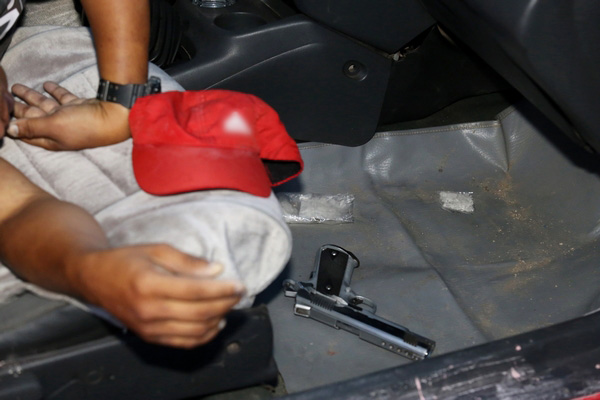CEBU RANKS THIRD IN DRUG KILLS

CDN file photo
Cebu City Mayor Tomas Osmeña says it’s not enough; Cebu should be number one
The number of bloody corpses sprawling on the streets in Cebu City and province was too many to ignore.
A study by researchers from the Ateneo de Manila University and De La Salle University showed that the city and province of Cebu ranked third in the most number of drug-related killings in the country, amid a relentless war on drugs that began soon after the national and local elections ended in May 2016.
Data culled and analyzed data from news reports from May 2016 to September 2017 showed that at least 383 persons in Cebu were killed either in a shootout with the police or gunned down by unknown assailants, said the study released on Tuesday by the Ateneo School of Government.
Metro Manila was in the top hotspot, accounting for 2,000 deaths; followed by Bulacan, at 644; and then Cebu, with 383.
The same report found out that majority of the victims of the bloody drug war were male and poor, such as tricycle drivers, construction workers, vendors and garbage haulers.
Supt. Reyman Tolentin, information officer of the Police Regional Office in Central Visayas (PRO-7), was not surprised with the number of persons killed in the war on drugs in Cebu.
“The number of persons involved in the illegal drugs trade in Cebu and other parts of Central Visayas is really high. So it’s but normal to also have more casualties here,” he said in an interview on Tuesday.
Osmeña’s wish
Cebu City Mayor Tomas Osmeña, however, was not contended with Cebu’s ranking.
“I wish we were number one. I wish all of them (drug criminals) would be shot,” he said in his regular press conference in City Hall on Tuesday.
Osmeña lashed out at those who criticized President Rodrigo Duterte’s war on drugs, saying they don’t understand the real situation.
“They are only concerned about criminals dying. They don’t care about the victims. If they (drug suspects) all die, that’s good for us,” he said.
“If it were not a crime or a sin, I’d do the killings myself. You wonder where all these drugs are coming but they are there,” he added.
Leo Villarino, chief investigator of the Commission on Human Rights in Central Visayas (CHR-7), said they will continue to monitor all the killings in Cebu to make sure justice is given to where it is due.
“Whether its 10,100, or 1,000, the number of killings should not reach that figure. Even one unnecessary death that remains unsolved is alarming for the community especially if authorities are not doing enough to solve these cases,” he said.
Regional figures
Based on the records of PRO-7, at least 180 drug suspects in the region were killed in shootouts with policemen, while 213 others were gunned down by still unknown assailants since July 1, 2016.
On the other hand, at least 9,466 drug suspects were arrested in the region, while some 108,742 drug users and pushers surrendered to authorities at the onset of Oplan Tokhang (toktok hangyo), a police door-to-door anti-drug campaign where suspects are asked to surrender and sign documents renouncing their involvement in illegal drugs, either as a user or a peddler.
Since the war on drugs started, PRO-7 has seized a total of 35,039 grams of shabu worth P363.8 million.
The Philippine Drug Enforcement Agency in Central Visayas (PDEA-7), on one hand, gunned down at least 14 drug suspects who allegedly put the lives of operatives at risk since July 2016.
The CHR-7 is looking into all the killings that involved policemen as the suspects.
Leia Albiar, PDEA-7 spokesperson, believed Cebu’s ranking in the study made by the two universities in Manila was due to the fact that the media here is active compared to other regions in the country.
“Cebu was highlighted because the media here keep on reporting the drug-related killings. In our country, there are 194 persons killed in legitimate police and PDEA operations since July 1, 2016. The number released in that study has more maybe because they included those killed by unknown assailants,” she explained.
The targets
On the part of PRO-7, Tolentin said there will be no let up in their campaign against illegal drugs.
Tolentin admitted that most of their targets are street level drug pushers or drug users as shown in the study made by Ateneo de Manila University and De La Salle University.
“Police stations tend to focus only on street level pushers or users,” he said.
If they go after drug lords, Tolentin said they need more police operatives.
As the killings in the drug war continued to rise two years on, the researchers and academics expressed hope that the patterns shown in the study would be used to provide evidence-based solutions to the drug problem.
Ronald Mendoza, dean of Ateneo School of Government, said drug smuggling and supply must also be curbed.
“Unless this is addressed, basically we are facing a never-ending stream of the challenges from moving forward,” he said.
He added that if the killings continue, the Philippines “may run out of citizens one day.” /WITH REPORTS FROM MOREXETTE B. ERRAM AND ROSALIE O. ABATAYO
Disclaimer: The comments uploaded on this site do not necessarily represent or reflect the views of management and owner of Cebudailynews. We reserve the right to exclude comments that we deem to be inconsistent with our editorial standards.
